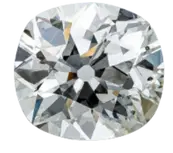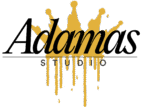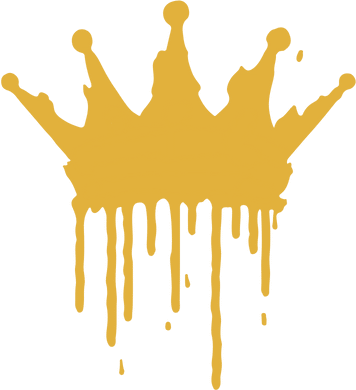
Gabrielle’s Ideals for Old Mine Cuts #
I’ll be honest with you – I don’t have specific ideals for antique cuts! Antique cuts are the perfect example of why we can’t just give a list of numbers to input and have a perfect diamond come out. We have two sides of antique cuts – modern antique cuts (lab diamonds that are cut in a faceting pattern of an antique stone) and recycled antique cuts (mined diamonds that are “authentic” in their antique status.) Each option offers gorgeous stones, but we have to rely on our eyes more than what the numbers say! This guide does offer overall ideals because, at this point, we know what bad looks like, but I hope you’ll trust us to help you find an antique cut stone through either a custom cut or one of our cutting and sourcing partners to send many videos to evaluate the stone.
The Old Mine Cut diamond is a historical predecessor to the modern brilliant cut, recognized for its soft, cushion-like shape, high crown, small table, and large facets. This antique cut is known for its deep, romantic glow rather than sharp brilliance, making it a favorite among vintage jewelry collectors and those who appreciate Old World charm.
First developed in the early 18th century, the Old Mine Cut was the dominant diamond cut during the Georgian and Victorian eras. Before the precision of modern cutting techniques, these diamonds were cut by hand, often following the natural shape of the rough crystal. This gives each Old Mine Cut diamond a unique, imperfect charm with a softer, candlelit sparkle compared to modern round brilliants.
Unlike contemporary diamond cuts, Old Mine Cuts prioritize fire over brilliance. They show more colorful light dispersion but have a less intense white-light sparkle than modern brilliant cuts. Their high crown, deep pavilion, and small table create a unique play of light, making them an excellent choice for those who love vintage aesthetics.
#
1. What Is an Old Mine Cut Diamond? #
An Old Mine Cut diamond is a vintage cushion-shaped cut with 58 hand-cut facets, a steep crown, a deep pavilion, an open culet, and a small table. Unlike modern cushion cuts (optimized for symmetrical brilliance), Old Mine Cuts often feature slightly off-center facets, asymmetry, and chunky light return—all part of their antique charm.
They were the primary diamond cut before the Old European Cut emerged in the late 19th century, and they remain highly sought after today for restoration pieces, heirloom jewelry, and those who appreciate a softer, hand-crafted look.
Why Choose an Old Mine Cut Diamond?
- Antique Elegance & Historical Charm:
Each Old Mine Cut diamond is unique, featuring hand-cut faceting and a soft, romantic glow.
- Maximized Fire Over Brilliance:
The large facets and deep proportions prioritize fire (rainbow-colored dispersion) rather than the bright white sparkle of modern brilliants.
- Eco-Friendly & Sustainable Choice:
Since Old Mine Cuts are typically repurposed from antique jewelry, choosing one means giving new life to an existing diamond.
- Unique, One-of-a-Kind Appeal:
No two Old Mine Cuts are exactly alike, making them an excellent option for those who love bespoke, individualistic jewelry.
Potential Downsides of an Old Mine Cut Diamond
- Less Brilliance Than Modern Cuts:
Due to its deeper cut and larger facets, an Old Mine Cut won’t have the same level of brilliance and scintillation as modern diamonds.
- Irregular Shape & Asymmetry:
Since these diamonds were hand-cut, many are imperfectly symmetrical, which, depending on personal preference, can either add to their charm or be seen as a flaw.
- Smaller Face-Up Appearance:
The deeper pavilion means Old Mine Cuts appear smaller than modern diamonds of the same carat weight.
- Open Culet (Visible Point at the Bottom):
The culet, often a small visible facet at the very bottom, can cause a small dark spot in the center of the diamond when viewed from above.
#
2. The 4Cs for an Old Mine Cut Diamond #
Unlike modern cuts, Old Mine Cut diamonds do not have strict “ideal” proportions since each one was cut by hand. However, these general guidelines help identify well-proportioned stones.
Cut – The Hallmark of a Beautiful Old Mine Cut
- Table Percentage: 38–45%
A small table creates more contrast between bright and dark areas.
- Depth Percentage: 60–70%
A deep pavilion gives Old Mine Cuts their iconic chunky light return.
- Pavilion Depth: 42–50%
A steeper pavilion enhances fire while sacrificing some brilliance.
- Crown Height: 16–22%
A high crown allows for deeper fire dispersion.
- Girdle Thickness: Thin to Slightly Thick
Since these diamonds were cut by hand, girdles may not be as uniform as modern cuts.
- Culet Size: Small to Medium (Avoid very large culets if you prefer less visible dark spots in the center).
Pro Tip: Look for Old Mine Cuts with evenly distributed light return, avoiding ones with too much extinction (dark areas).
Color – A Warmer Vintage Look
Unlike modern diamonds, Old Mine Cuts were often cut to embrace warmer tones, as colorless diamonds weren’t a priority until later grading systems were developed.
- D–F (Colorless): Rarer in antique cuts, but some older diamonds can still achieve a bright, white appearance.
- G–J (Near Colorless to Faint Color): The sweet spot for vintage lovers, offering warmth while still appearing bright in most lighting.
- K–M (Faint Yellow to Light Yellow): A classic antique look, often chosen for those who love warm-toned diamonds.
Pro Tip: If setting an Old Mine Cut in yellow or rose gold, warmer color grades (J–M) blend beautifully. If set in platinum or white gold, stay within the D–H range for a crisp contrast.
Clarity – Eye-Clean Is Key
Since Old Mine Cuts have larger, open facets, inclusions can be more visible than in modern brilliant cuts.
- VS1–VS2: The best balance of clarity and value.
- SI1–SI2: Some SI1 stones will be eye-clean, but inspect carefully for visible inclusions.
- VVS1–VVS2: High clarity, but less critical for antique cuts unless you prefer perfection.
Pro Tip: Clarity in Old Mine Cuts should be assessed in natural lighting, as they perform differently than modern cuts under magnification.
Carat – Old Mine Cuts Face Up Smaller
Due to their deep pavilion, Old Mine Cut diamonds face-up smaller than modern brilliant cuts.
Pro Tip: If size appearance is a concern, consider going up in carat weight to achieve a larger face-up look.
3. Additional Considerations #
Symmetry & Polish
- Symmetry: Expect natural, hand-cut asymmetry, which adds to the charm.
- Polish: Many antique diamonds have Good to Very Good polish, as older cutting techniques weren’t as precise.
Fluorescence
- Some antique diamonds exhibit strong fluorescence, which can enhance or detract from their beauty, depending on preference.
Certification
- Certification: Antique cuts may not always come with standard IGI or GIA reports. We assure you it will be certified if we’re looking at a modern cut antique stone. Suppose we are sourcing a recycled/pre-loved earth-mined antique diamond for you. In that case, we assure you that we purchase from reputable antique jewelers or seek an independent appraisal for quality assurance.
Setting Considerations
- Best Settings:
- Bezel settings enhance the vintage look and provide protection.
- Prong settings allow more light exposure for better fire.
- Halo settings amplify size while preserving antique charm.
- Metal Choice:
- Yellow & rose gold complement warmer-toned Old Mine Cuts.
- Platinum & white gold create a striking contrast with near-colorless stones.
#
Final Thoughts #
An Old Mine Cut diamond is a timeless, historically-inspired treasure. It offers a unique, romantic alternative to modern precision-cut diamonds. An Old Mine Cut is a perfect heirloom-worthy choice if you love vintage aesthetics, chunky facets, and soft, candlelit fire.
Following these guidelines, you can find a well-proportioned, high-performing Old Mine Cut diamond that balances charm, history, and brilliance.
Happy diamond hunting—may your Old Mine Cut diamond bring the elegance of the past into your future!


